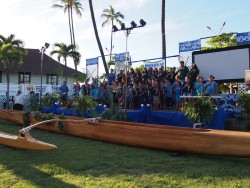Kulaia: One Community, One Wa`a
Last Friday on the closed main street of Kaunakakai town, children spoke Hawaiian fluidly. Community members pounded poi while shop owners told ancestral stories through their handmade crafts. Hawaiian culture was alive and well at Molokai’s second annual Kulaia, a celebration whose purpose was reconnecting with traditions of the past.
“I like the idea that it’s a historical event that we’re trying to revive in our own Molokai way,” said resident Pulama Lima. “… I think it brings our community together in a way that people look at us as this model of aloha and this model of why we still continue this life of subsistence.”
An event that once accompanied outrigger races and national holidays in mid-1800s Hawaii, Kulaia was planned to accompany this year’s Na Wahine O Ke Kai. While the race was cancelled the next day due to weather, paddlers and local families still got a chance to celebrate community and culture.
Tents filled the street with the smells of garlic shrimp, barbecue chicken and warm malasadas as hundreds of people browsed local business merchandise or sat on the library lawn watching performers like Amy Hanaialii, Makaha Sons and Na Pua Ho`oheno. The festivity was reminiscent of years past when paddlers and residents camped together at Hale O Lono Harbor before big races.
“I think it’s awesome, bringing all the paddlers from all over the world and the community,” said Lisa Morgado of Kailua Canoe Club. “Together we can help support your economy here and have a nice time.”
Boosting the economy was one of the reasons for restoring Kulaia. At last week’s event, space was reserved solely for Molokai-based food and craft vendors, “to keep money on Molokai,” said Lori-Lei Rawlins-Crivello, one of the Molokai Canoe Festivals Committee members who organized the event.
“It’s such an international race that we hit customers that we normally wouldn’t,” said Molokai’s Ane Batukis, co-owner of Kealopiko, whose organic clothing is inspired by Hawaiian plants and animals. “We’re always reaching new people and sharing stories with new people.”
Visitors and residents also heard the stories of cultural practitioners, who demonstrated the craft of making lei, pounding poi, turning awa into a beverage and giving lomilomi massages. Resident Josh Pastrana explained how the `awa root is cleaned, ground up and mixed with water. The drink has a calming effect that relaxes the muscles and the mind, he said, and is a healthier alternative to beer.
“It’s used a lot in ceremony but even socially. It [creates] a good place where people sit down and talk story about what went on in the day, if they had pilikea or problems,” said Pastrana. “We’re just carrying on the tradition of our kupuna and trying to promote a little more healthy lifestyle.”
This year’s event honored “wahine and the maternal energy of protecting, nurturing, and propagating our natural resources.” Speaking in ka `olelo makuahine, the mother tongue, Hawaiian immersion students described how the theme “Hina i uka, Hina i kai” reminded them of their mothers and grandmothers, and how everybody on Molokai as children of Hina, “together possess her maternal energy,” explained event organizer and Hawaiian language instructor Nahulu Maioho.
Students also placed kukui lei on Kukui O Kanaloa, a koa canoe that occupied center stage for the event.
“It symbolizes the mana of Molokai,” said event organizer Kawika Crivello. “That [wa`a] represented we as a people of Molokai welcoming the many other wa`a and clubs.”
In past Kulaia celebrations, ali`i were honored. The Canoe Festivals Committee carried on elements of this tradition by recognizing community leaders. They paid tribute to the late Mel Paoa, a former Hokulea crewmember who was honored at last year’s event, as well as kupuna Kauila Reyes, a respected kumu hula and preschool teacher. The 89-year-old Reyes performed an upbeat hula to rousing cheers.
Bringing the community together for Kulaia, visitors and residents alike, said Crivello, allowed Molokai to share its messages of aloha and sustainability.
“To share the message of who we are we had to put this Kulaia together again, to bring the paddlers and the visitors to come and meet the people,” said Crivello. “When you understand the people, you understand the message.”
Visiting paddlers said they appreciated the opportunity to celebrate with Molokai residents.
“We feel welcomed, it’s so lovely to be able to meet the locals,” said New Zealand paddler Tracy Gilmore. “It’s nice to have this time to connect all together. This race isn’t just about racing, it’s also about the traditions and values.”














Don't have a Molokai Dispatch ID?
Sign up is easy. Sign up now
You must login to post a comment.
Lost Password